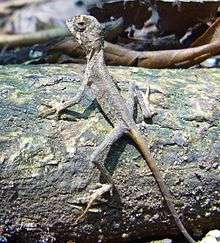Otocryptis wiegmanni
Otocryptis wiegmanni, commonly called the brown-patched kangaroo lizard, Sri Lankan kangaroo lizard or Wiegmann's agama, is a small, ground-dwelling agamid lizard endemic to Sri Lanka.
| Otocryptis wiegmanni | |
|---|---|
 | |
| Otocryptis wiegmanni at Udawattakele, Kandy, Sri Lanka. | |
| Scientific classification | |
| Kingdom: | Animalia |
| Phylum: | Chordata |
| Class: | Reptilia |
| Order: | Squamata |
| Suborder: | Iguania |
| Family: | Agamidae |
| Genus: | Otocryptis |
| Species: | O. weigmanni |
| Binomial name | |
| Otocryptis weigmanni Wagler, 1830 | |
| Synonyms[1] | |
Etymology
The specific name, wiegmanni, is in honour of German herpetologist Arend Friedrich August Wiegmann.[3][1]
Habitat
The preferred habitat of O. wiegmanni is the wet zone forests and lower mountain forests (rainfall >2000 mm[4]), up to 1,300 m (4,300 ft), of Sri Lanka. It is commonly seen in the leaf litter of shady rain forests.[5][6]
Defensive behaviour
When perceiving danger, O. wiegmanni spurts away quickly on its large hind legs and might eventually climb up a sapling or tree.[5][6]
Taxonomy
O. wiegmanni is closely related to the Indian kangaroo lizard (O. beddomii ) of the rain forests of South India.
Description
O. wiegmanni may grow to an adult body size of about 7 cm (2.8 in) snout-to-vent length (SVL), plus a tail 15 cm (5.9 in) long. Its colour ranges from dark reddish brown to dull brown. Males are darker than females.[5][6] Males have a maroon patch on their gular sac.[4]
Reproduction
Male O. wiegmanni are territorial and can defend their territory against intruders through displays and fights.[4] Females lay between three and five eggs in a nest in the ground between July and January, with a peak between October and January.[5][6] The eggs are ellipsoidal, measuring 7 mm–7.5 mm × 10 mm–17 mm (0.28 in–0.30 in × 0.39 in–0.67 in). Hatchlings emerge after 57–70 days.
References
- Otocryptis wiegmanni at the Reptarium.cz Reptile Database. Accessed 27 June 2017.
- Wagler J (1830). Natürliches System der AMPHIBIEN, mit vorangehender Classification der SÄUGTHIERE und VÖGEL. Ein Beitrag zur vergleichenden Zoologie ". Munich, Stuttgart and Tübingen: J.G. Cotta. vi + 354 pp. + one plate. (Otocryptis wiegmanni, new species, p. 150). (in German and Latin).
- Beolens, Bo; Watkins, Michael; Grayson, Michael (2011). The Eponym Dictionary of Reptiles. Baltimore: Johns Hopkins University Press. xiii + 296 pp. ISBN 978-1-4214-0135-5. (Otocryptis wiegmanni, p. 285).
- Karunarathna, D. M.S. Suranjan; Amarasinghe, A. A. Thasun (2007). "Notes on the territorial behaviour of Otocryptis wiegmanni Wagler, 1830 (Reptilia: Agamidae: Draconinae)". Herpetotropicos. 4 (2): 79–83.
- Deraniyagala PEP (1953). A Colored Atlas of some Vertebrates from Ceylon, Volume 2. p. 58.
- Das, Indraneil; de Silva, Anslem (2005). Photographic Guide to Snakes and other Reptiles of Sri Lanka. London. p. 88.
External links
| Wikimedia Commons has media related to Otocryptis wiegmanni. |
Further reading
- Boulenger GA (1885). Catalogue of the Lizards in the British Museum (Natural History). Second Edition. Volume I ... Agamidæ ... London: Trustees of the British Museum (Natural History). (Taylor and Francis, printers). xii + 436 pp. + Plates I-XXXII. (Otocryptis bivittata, pp. 271–272).
- Smith MA (1935). The Fauna of British India, Including Ceylon and Burma. Reptilia and Amphibia. Vol. II.—Sauria. London: Secretary of State for India in Council. (Taylor and Francis, printers). xiii + 440 pp. + Plate I + 2 maps. (Otocryptis wiegmanni, pp. 146–147).